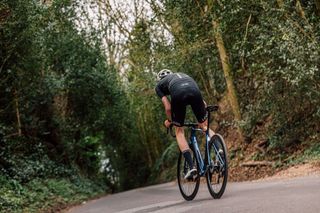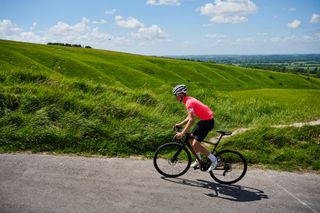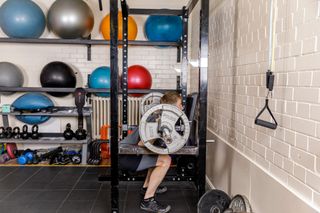Many factors influence a rider’s speed on the bike, but power to weight is undeniably crucial.
The ratio is calculated, very simply, by dividing the watts produced (measured via a power meter), by kilograms in weight: watts/kg. All things being equal, the higher the number, the faster a rider will go.
However, it’s important to be aware that losing too much weight, or losing it too quickly, can impact power production – negating any speed gains made by shedding the extra pounds. For some riders, increasing power by following a cycling training plan may be more productive than losing weight.
It’s also important to understand the effect of gradient on these equations. A rider who can put out 300 watts as their Functional Threshold Power (FTP) but weighs 100kg will have the same watts per kilo (w/kg) as a 50kg rider who has an FTP of 150 watts. However, on the flat (where weight doesn’t play a large role), the heavier and more powerful rider will have a sizable advantage over the lighter rider. But as the road tips upwards, the advantage of raw wattage dwindles and w/kg becomes the most important number.
Although the two riders as described would be evenly matched on the climbs, the lighter rider doesn’t have to add many more watts to gain the advantage here. An FTP increase to 175w would see the 50kg rider’s k/kg leap to 3.5 w/kg – conferring a significant advantage on the climbs.
Understanding power-to-weight ratio/watts per kilogram

(Image credit: Future)
Those are the fundamentals. Simply put, there are three ways by which a rider’s w/kg can be increased:
- Increasing power output while keeping weight constant
- Keeping power output constant while decreasing weight
- Increasing power output while also decreasing weight
It’s important to note that if you gain weight – whether through increased muscle mass or otherwise – whilst increasing your power output, your w/kg will not improve and you won’t see a benefit on the climbs (although you will be faster on the flat, all else being equal).
The latest race content, interviews, features, reviews and expert buying guides, direct to your inbox!
Likewise, if your power declines significantly as you lose weight, your w/kg will similar not improve – plus your performance on the flat (where raw wattage matters most) will suffer as well.
The table below shows the relationship between power, weight and w/kg. Looking at this table, notice how the w/kg number rises as power output rises and bodyweight falls – i.e. higher and further to the right in this table. Notice, too, how any given power-to-weight ratio (we’ve highlighted 3W/kg) can be achieved at much lower absolute power outputs when the rider’s mass is low. For example, a 50kg rider churning out just 150 watts has the same power-to-weight ratio as a 90kg rider churning out 270.
Now suppose this 90kg rider wants an improved power-to-weight ratio. If he or she sheds 10kg (down to 80kg), P/WR jumps from 3.0 to 3.4W/kg – that’s a bigger (and in most cases more attainable) improvement than staying at the same weight and developing their aerobic fitness to add another 30 watts and hit 300w. This underlines why shedding excess body mass (fat) is so effective at boosting performance – even if your aerobic fitness remains the same.
| Row 0 – Cell 0 | 120w | 150w | 180w | 210w | 240w | 270w | 300w | 330w | 360w | 390w |
| 45kg | 2.7 | 3.3 | 4.0 | 4.7 | 5.3 | 6.0 | 6.7 | 7.3 | 8.0 | 8.7 |
| 50kg | 2.4 | 3.0 | 3.6 | 4.2 | 4.8 | 5.4 | 6.0 | 6.6 | 7.2 | 7.8 |
| 55kg | 2.2 | 2.7 | 3.3 | 3.8 | 4.4 | 4.9 | 5.4 | 6.0 | 6.5 | 7.1 |
| 60kg | 2.0 | 2.5 | 3.0 | 3.5 | 4.0 | 4.5 | 5.0 | 5.5 | 6.0 | 6.5 |
| 65kg | 1.8 | 2.3 | 2.8 | 3.2 | 3.7 | 4.1 | 4.6 | 5.0 | 5.5 | 6.0 |
| 70kg | 1.7 | 2.1 | 2.6 | 3.0 | 3.4 | 3.8 | 4.3 | 4.7 | 5.1 | 5.6 |
| 75kg | 1.6 | 2.0 | 2.4 | 2.8 | 3.2 | 3.6 | 4.0 | 4.4 | 4.8 | 5.2 |
| 80kg | 1.5 | 1.9 | 2.2 | 2.6 | 3.0 | 3.4 | 3.8 | 4.1 | 4.5 | 4.9 |
| 85kg | 1.4 | 1.8 | 2.1 | 2.5 | 2.8 | 3.2 | 3.5 | 3.9 | 4.2 | 4.6 |
| 90kg | 1.3 | 1.7 | 2.0 | 2.3 | 2.7 | 3.0 | 3.3 | 3.7 | 4.0 | 4.3 |
| 95kg | 1.2 | 1.6 | 1.9 | 2.2 | 2.5 | 2.8 | 3.2 | 3.8 | 3.8 | 4.1 |
What is a good power to weight ratio?
What would be a ‘good’ W/Kg? Well, this depends on the time period and the level at which you’re riding. Dr Andrew Coggan, an internationally acclaimed exercise physiologist, has compiled some typical power-to-weight ratios, which are shown in the table below:
| Rider type | 5 mins (male/female) | 1 hour (male/female) |
| Professional | 7.0 / 6.15 | 6.0 / 5.36 |
| Amateur | 3.7 / 3.19 | 3.0 / 2.57 |
| Recreational | 2.5 / 2.07 | 1.8 / 1.5 |
Is power-to-weight ratio important in cycling?

(Image credit: Dan Gould)
As we saw earlier, shifting mass uphill means that you have to work against the force of gravity. This explains why power-to-weight ratio becomes especially important when climbing. However, absolute power is still important.
To illustrate this, let’s compare power requirements of a 70kg and 80kg rider riding a superlight 6kg road bike up a hill of seven per cent gradient at 16kph (10mph) in still winds. Using data on rolling and aerodynamic resistance, we can calculate that an 80kg rider would have to maintain an average power output or around 298W, requiring a power-to-weight ratio of 3.73W/kg. The 70kg rider would only need to average 266W to ride up the same hill at the same speed on the same bike. However, although it’s 32W less power overall, this translates into a slightly higher power-to-weight ratio of 3.80W/kg.
Why is this? In simple terms, although much of the riders’ power requirements are a function of body mass (because they’re climbing), there’s an extra, fixed amount of work that has to be done to push the air out of the way (i.e. overcoming aerodynamic resistance), which is the same for both riders. As speeds rise, the contribution from aerodynamic resistance becomes proportionately greater. This in turn begins to favour absolute power output over power-to-weight.
Of course, it’s worth bearing in mind that, in a real-life scenario, the heavier rider is likely to be physically larger and have greater frontal surface area, increasing their aerodynamic resistance further (a discussion to be explored another time). To illustrate this, let’s now suppose that the riders are travelling twice as fast (32kph) but the gradient is half as steep (3.5 per cent).
The rate of ascent overall is still the same and the 70kg rider still requires around 32W less power than the 80kg rider to maintain a speed of 32kph. However, both riders have had to find a massive 163W extra to overcome the increased aerodynamic resistance experienced at 32kph compared to the resistance at 16kph.
So, your power to weight ratio is important, but only really when cycling up steeper climbs. Still, for professional cyclists, it is the climbs which really matter. On the flat, drafting behind the rider in front can save you around a third of the wattage to maintain that speed – if the person in front is putting out 350W, you may only have to put out 231W to hold the wheel.
This means it’s difficult for the strongest riders to pull away, as they would have to put out significantly more watts than the people behind them. On steep climbs, though, the benefits of drafting are greatly reduced because the speeds are so much slower. It’s on these climbs that the strongest riders can put time into their weaker competitors. But, as we’ve covered, speed on steeper climbs is determined not only by your watts, but also by your weight – which is why a rider’s power to weight ratio is quite so important.
What does this mean in practice?

(Image credit: Future)
Essentially, the hillier the terrain, the more your power-to-weight ratio matters. The flatter the terrain, the less power-to-ratio matters and the more absolute power output comes into play (figure 1). We can draw another conclusion: when power-to-weight ratios are identical, the rider with the highest absolute power will be faster.
For example, if rider A weighs 80kg and can sustain 240W, while rider B weighs 70kg and can sustain 210W, they both have a power-to-weight ratio of 3W/kg. But A will be faster because he/she will have more power to overcome aerodynamic and frictional drag.
The flatter the terrain, the more important absolute power becomes.
The hillier the terrain, the more important power-to-weight becomes.
Testing your own power output
Calculating your own power-to-weight ratio requires only two measurements: your weight and your maximum sustainable power output. The first is easy to measure – just hop on some accurate bathroom scales. The second requires a power output measurement. To do this, you’ll need to use a bike with a reliable power meter fitted – or better still, hop on an accurate, power-reading smart indoor trainer, where you can pedal furiously without needing to slow down for bends, traffic, etc.
To measure your maximum sustainable aerobic power, ride gently for 10 minutes to make sure you’re thoroughly warmed up. Take a couple of minutes’ rest, then ride as hard as you possibly can for 20 minutes and record your average power output figure in watts. This is your 20-minute maximum sustainable power output.
Your one-hour maximum sustainable power output will be around five per cent lower (depending on fitness) than this figure, e.g. a 20-minute figure of 275W would equate to around 260W for an hour. Your five-minute maximum power will likely be around 10 per cent higher than the 20-minute figure, e.g. in this example, around 295W.
How do you increase your power-to-weight ratio in cycling?

(Image credit: Future)
We’ve seen that increasing power, reducing body weight or a combination of both can significantly improve your power-to-weight ratio. But how can you best achieve this? This will depend on your cycling background:
Relative beginners/novices
Simply riding more miles will boost your power-to-weight ratio. Putting in more miles will not only boost your level of aerobic fitness (i.e. your sustainable power output); you’ll almost certainly lose a bit of excess body fat in the process. For example, if you drop from 86 to 82kg and increase your 20-minute power output from 210 to 235W, your power-to-weight ratio increases from 2.4W/kg to a very respectable 2.9W/kg.
Fitter and more experienced riders
You need to be a bit more focused than simply adding more miles. Yes, more miles might result in reduced body weight, but add too much extra volume and you run the risk of fatigue and burnout. Moreover, an attempt to reduce weight when your body-fat levels are already quite low can lead to muscle mass loss as well as fat loss.
Given that power is generated by your muscle tissue, you might end up reducing your weight and losing some power with it – resulting in minimal improvements to your power-to-weight ratio. In fact, it’s worth remembering that absolute power is most important on the flat and even on gentle climbs. If you add both weight and power, although you won’t be any faster on the steepest climbs, you’ll still be faster elsewhere.
As a result, the best option is generally to include some specific training to boost your maximal power output. This includes sessions such as intervals (long and shorter, more intense), hill repeats and some threshold rides. Because these sessions are quite demanding, make sure you build in sufficient recovery time into your weekly cycling training plan – it’s during recovery that your muscles adapt and become more powerful.
Weight training

(Image credit: Future)
Another useful strategy, especially for more accomplished riders, is to perform some regular strength training. Studies have shown that performing heavy resistance training for the key cycling muscles (quadriceps, hamstrings, buttocks and calves) not only boosts muscle efficiency, it can help prevent the loss of muscle power during periods of high-volume training, or during periods of weight loss.
Regardless of your riding ability, consuming a healthy diet, avoiding an excess of sugary, fatty and (especially) processed foods will play a part in improving power-to-weight ratio. All other things being equal, higher intakes of sugar and sugary foods in particular have been unequivocally linked with higher levels of body fat.
Unlike muscle tissue, excess body fat blunts power-to-weight ratio and contributes nothing to power output. By the same token, a plentiful intake of dietary protein is recommended, especially after training. Protein is needed for recovery and repair after training, and studies show that higher intakes of protein can help prevent muscle mass loss when training volumes are high.

